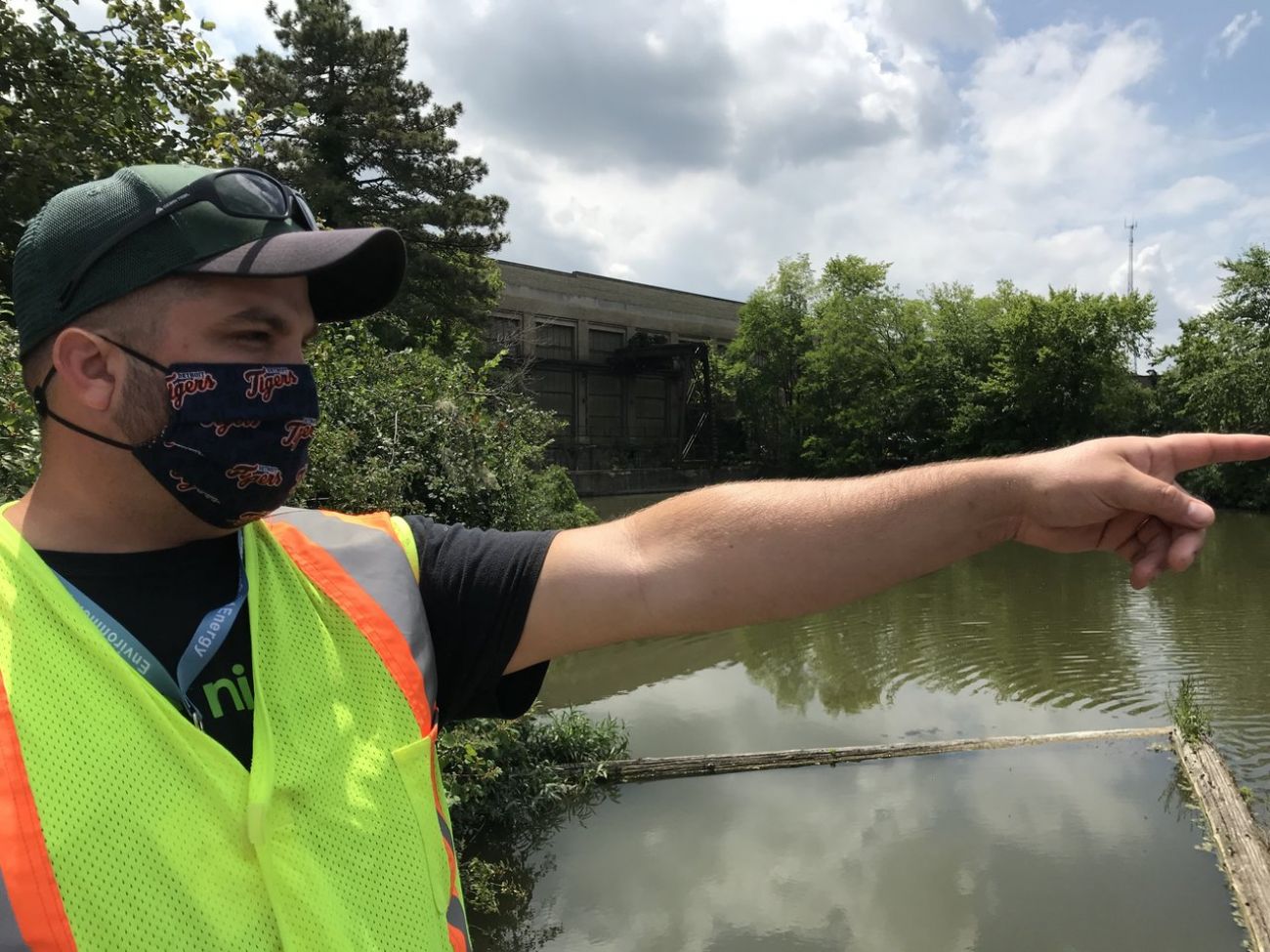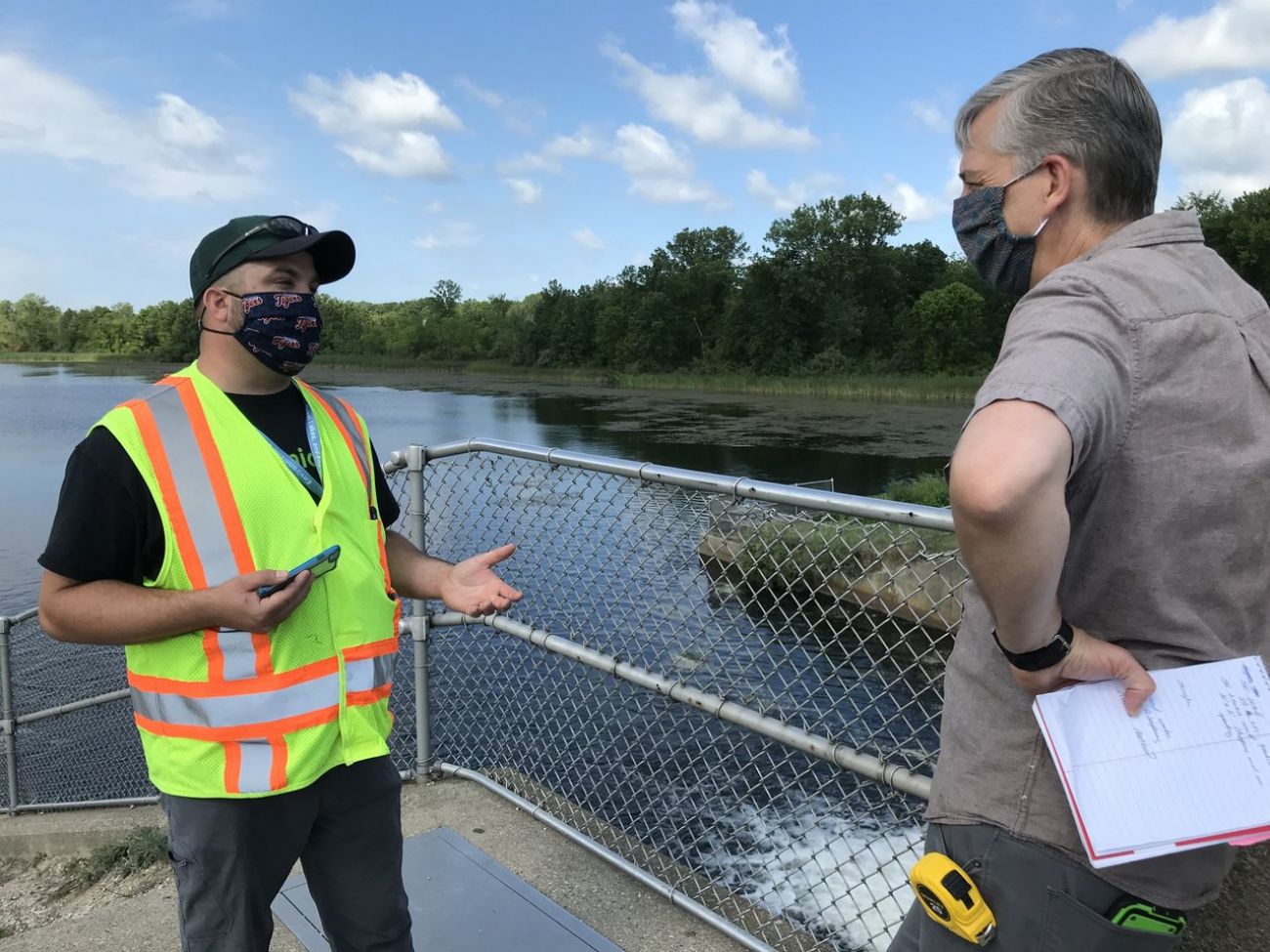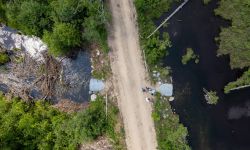Edenville Dam inspector: ‘People want to point fingers,’ but I did my best

After a decade as one of two state inspectors responsible for ensuring the safety of Michigan’s 1,059 state-regulated dams, Luke Trumble is finally about to get a new colleague.
All it took was a catastrophic dam failure and $200 million in damages to begin rebuilding a regulatory program that state officials and outside experts have repeatedly warned does not have enough staff or funding to keep Michigan’s dams safe.
“It’s a big step in the right direction,” Trumble said. “When you only have two staff, you’re limited in how much you can do, so increasing the workforce by 50 percent will help.”
Related:
- Should taxpayers foot the bill for restoring the Midland dams?
- Two heirs bought Midland dams as a tax shelter. Tragedy followed.
- Crises collide: Flood recovery workers carried COVID-19 to Michigan
- Two heirs bought Midland dams as a tax shelter. Tragedy followed.
- Judge: Edenville Dam still poses ‘grave risk,’ needs immediate inspection
On Thursday, officials in the Michigan Department of Environment, Great Lakes & Energy announced plans to hire a third inspector as part of its response to the May 19 Edenville Dam failure that damaged more than 2,500 buildings in Gladwin, Midland and Saginaw counties,
The agency has also tapped outside experts and announced a new task force to suggest other changes to Michigan’s dam safety regime. Legislative inquiries and class-action lawsuits, meanwhile, have questioned why federal and state regulators knew the dam was faulty for years but failed to take action.
Trumble and the state inherited oversight in September 2018, when federal regulators revoked the permit of the dam’s owner, Boyce Hydro LLC, to generate power. He and another colleague authored a cursory inspection of the dam that deemed it in “fair condition.”
But Michigan has flood-control standards that are half as strong as federal ones for high-hazard dams like Edenville, and state officials were awaiting a report on the 96-year-old dam’s ability to meet that lower standard when it failed amid heavy rains. In the meantime, they were working with a local task force that planned to buy the dams and repair them—a path Trumble said he thought would yield results faster than pressuring Boyce to make needed fixes.

“People want to point fingers and that’s part of the job and I understand that,” Trumble said, adding the dam’s safety issues were “not something you can just walk out there with a shovel and excavator and fix.”
A Beaverton native, Trumble grew up just miles from the dam and its impoundment, Wixom Lake. For 10 years, he’s worked in relative obscurity, his days filled with paperwork, field inspections, phone calls and meetings.
But in the two months since the failure of the Edenville and nearby Sanford dams, he has been consumed with media requests and legislative inquiries. He defended the state’s response, acknowledging inspectors worried the dam would fail in a massive flood but noting those are exceedingly rare. State officials have called the Edenville flood a 500-year event.
“That dam operated safely, more or less, for almost 100 years,” Trumble said.
He said regulators were focused on facilitating a sale of the dam from Boyce Hydro LLC., which insisted for years it didn’t have money for repairs, to the Four Lakes Task Force, a group of lakeside property owners who planned to repair Boyce’s four mid-Michigan dams.
“If the flood would have waited a couple years, the dam probably could have handled it,” Trumble said.
For weeks after the failure, he worked 16-hour days, traveling from his home in Lansing to a Midland emergency operations center as the sun rose, then returning home to continue working late into the night.
The experience, Trumble said, has been stressful. In the days after the failure, with Midland still underwater, evacuees returning to find homes destroyed, and questions swirling about how the dam failed and who is to blame, Trumble recalled helping a stranded driver change a flat tire.
It felt like a blessing, he told Bridge.
“Something controllable,” he said, amid a disaster that had plunged his world into chaos.
Years of low funding
The plan to add an inspector to the small state dam safety unit is likely the first of many proposed changes designed to bolster Michigan’s dam safety in response to Edenville.
While an independent investigation team works to determine what caused Edenville’s failure and who is responsible — a process that could take 18 months — the Association of State Dam Safety Officials will conduct an independent review of the dam safety program.
A state release Thursday said the review will “recommend ways to improve the performance and management of the program and evaluate its mission, objectives, and policies and procedures.”
A task force of state and federal officials, local governments and others will build upon that report to recommend their own fixes.
Funding and staffing in Trumble’s unit, which is far lower per-dam than the national average, is likely to be a part of the discussion.

Michigan’s dam safety unit budget in 2018 was just under $400,000. That works out to about $374 on regulation per dam. The average state spends $695 per dam in safety regulation, said Jacob Rushlow, Michigan section president for the American Society of Civil Engineers.
Trumble said he welcomes suggestions for how the unit can improve. But, he added, “for only two inspectors, we do a pretty good job.”
Every one of Michigan’s state-managed dams must be inspected every three to five years. It would be difficult for the state’s two inspectors to keep up with the workload.
So the state requires the owners of Michigan’s 803 state-regulated private dams to hire their own consultants to inspect the structures. Trumble and Dan DeVaun, his colleague in northern Michigan, are available to inspect any of the 350 publicly-owned dams under their jurisdiction at the owner’s request. Trumble estimated about half of them take the state up on the offer. Another 1,370 smaller dams are not regulated at all, and 92 fall under federal oversight.
On a recent round of inspections this month at four smaller dams in southeast Michigan, Trumble paced the grassy embankments, looking for irregularities in their slope, as well as damp spots or wetland plants that could indicate the dam is leaking. He documented his findings in photographs, which he’ll compile along with a written report, sending it all to the dam owner with a list of recommended actions.
This time, Trumble’s recommendations were minimal: Keep vegetation mowed on the embankment. Monitor some minor erosion in an area where anglers have cut a boot path down to the reservoir. Keep an eye on some minor blemishes in the dam’s concrete.
When state inspectors identify a problem, they alert the owner and direct them to make repairs. But because many dam owners lack money for repairs and maintenance, Trumble sometimes finds himself flagging the same problem repeatedly over multiple inspections.
“The typical dam owner wants to do the right thing,” Trumble said. “Fining is sometimes counter-productive because it takes money away from the repairs.”
‘There’s no ‘Easy’ button’
The state’s decision-making process at Edenville underscores a fundamental obstacle to quickly addressing dam safety problems: Inspectors can cite dam owners who refuse to comply, but can only step in and order repairs unilaterally if a dam’s deficiencies pose an imminent danger.
Trumble said the problem must be so dire that the dam could fail at any moment. He has taken unilateral action a handful of times, on small dams where the fix cost a few thousand dollars or less. In some cases, it required no money at all — just staff time to remove the stop logs holding back small small reservoirs.
The problems at Edenville, he said, weren’t dire enough to warrant emergency action. And even if they had been, the state has no money for such repairs.
“There’s no ‘Easy’ button, or we would have pushed it,” Trumble said.

Legislators have historically been reluctant to dedicate more funding to dam safety, despite repeated warnings that without it, failures will become increasingly common.
A 2004 policy document from the Department of Environmental Quality (which has since been renamed to EGLE), warned that lack of funding for repair was causing dams to become “seriously degraded.”
Instead of boosting funding, lawmakers acting on a budget proposal from then-Gov. Jennifer Granholm eliminated what was then a three-inspector dam safety unit amid budget cuts in 2005. They restored the unit seven months later with two inspectors.
In 2007, the Michigan River Partnership, a coalition of government and nonprofit groups, concluded that Michigan needs a dedicated state fund for dam rehabilitation and removal. Nothing came of it, said Mark Coscarelli, a senior policy fellow at Public Sector Consultants who led the effort.
“It gets back to the old thing of, what are our priorities in the public policy arena?” Coscarelli said. “It’s health care, it’s criminal justice, and then you’ve got some boring old dams.”
State leaders received a similar message in 2016 from then-Gov. Rick Snyder’s 21st Century Infrastructure Commission, which estimated Michigan needed $227 million over 20 years to achieve dam safety goals.
Two years later, the American Society of Civil Engineers again recommended more state funding and additional staff, warning that “deficiencies identified during dam inspections often remain uncorrected, sometimes for decades, because their owners do not have the money to repair or remove them.”
Rushlow, of the society’s Michigan section, said report authors took their suggestions to the Capitol, pushing “as hard as we could to get the information out there.” They sought meetings with legislators and dropped pamphlets in their mailboxes.
“It's going to cost less now to invest to make those needed repairs, than it’s going to cost to replace or rebuild something that drastically fails,” Rushlow said.
‘The system failed’
The Midland dams saga may prove that point: Before the Edenville and Sanford dams failed, the Four Lakes Task Force planned to spend up to $35 million to buy and repair Boyce’s four mid-Michigan dams.
The failure has ballooned repair costs to $340 million, plus another $20 million to deal with erosion and other immediate issues caused by the failure, said task force Chairman David Kepler.
Aside from Boyce and its owner, Lee Mueller, Kepler said he doesn’t blame any one person or agency for the disaster.
“The system failed,” Kepler told legislators during an appearance Tuesday before a joint senate committee. “These dams should have survived these storms.”
The state, he said, needs to do more to make sure dam owners are financially capable of maintaining their dams. And it should examine the “handoff protocol” between federal and state regulators when a dam loses its federal license and becomes state-regulated.
Rep. Sue Allor, R-Wolverine, chairs the Appropriations Subcommittee on Natural Resources and Environmental Quality whose members questioned Trumble and other EGLE officials last month about the dam safety program’s policies and staffing.
In light of the disaster, Allor said, she wanted to know “exactly what they do, and funding that might be needed.”
Allor said she was pleased to hear the state is hiring a new inspector, but she conceded that any effort to bolster dam safety funding could prove difficult as the state braces for a $3 billion budget gap for the fiscal year beginning Oct. 1.
“We’re going to have to get very creative in looking at the budgets,” Allor said.
Mark Ogden, a technical specialist with the Association of State Dam Safety Officials, said Pennsylvania’s system could provide a model. There, state law requires dam owners to prove they can cover costs of needed dam repair, maintenance, or removal. A law passed in 2018 established a state fund, backed by fees from private dam owners, to help cover such costs. Dam owners must comply with state safety regulations and current on inspections to participate in the fund.
Some landowners surrounding the lakes—which are now rivers surrounded by debris fields after regulators ordered them drained for safety following the floods—say policy fixes may be needed too.
Mark Mudge, a task force member and Smallwood Lake homeowner, said he ultimately blames Boyce for the failure.
But “I don’t think the state is blameless,” he said. They could have pressured the company to repair Edenville, rather than counting on new owners to make repairs in the future, Mudge said.
“They knew there were problems, and I don’t know why they didn’t act faster.”
Trumble said he welcomes suggestions for reforms. He, too, has been thinking hard about how the state could better prevent future disasters like the one at Edenville, he said.
“If I need to take some criticism, I’m prepared to do that,” he said. But funding, staffing and changes to the laws that set Michigan’s dam safety standards “can’t come from me.”
“We need to work with the Legislature to help them understand where we need help, where they can help, and what’s appropriate for the level of safety that we’re trying to achieve.”
Michigan Environment Watch
Michigan Environment Watch examines how public policy, industry, and other factors interact with the state’s trove of natural resources.
- See full coverage
- Subscribe
- Share tips and questions with Bridge environment reporter Kelly House
Michigan Environment Watch is made possible by generous financial support from:
Our generous Environment Watch underwriters encourage Bridge Michigan readers to also support civic journalism by becoming Bridge members. Please consider joining today.
See what new members are saying about why they donated to Bridge Michigan:
- “In order for this information to be accurate and unbiased it must be underwritten by its readers, not by special interests.” - Larry S.
- “Not many other media sources report on the topics Bridge does.” - Susan B.
- “Your journalism is outstanding and rare these days.” - Mark S.
If you want to ensure the future of nonpartisan, nonprofit Michigan journalism, please become a member today. You, too, will be asked why you donated and maybe we'll feature your quote next time!






